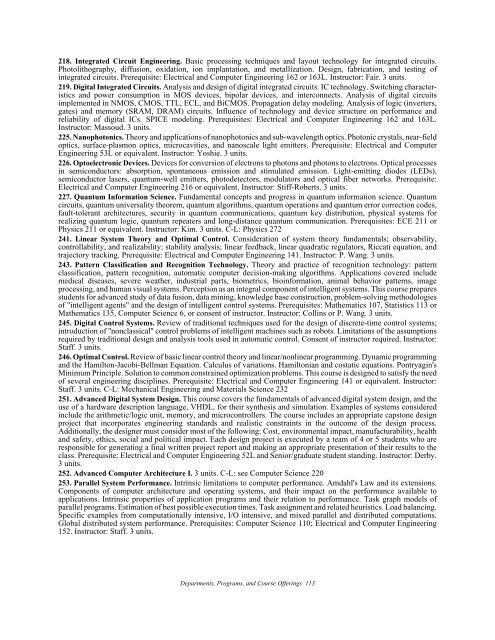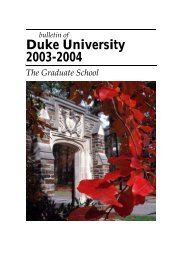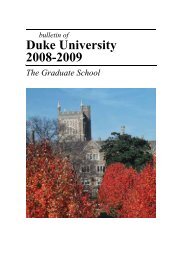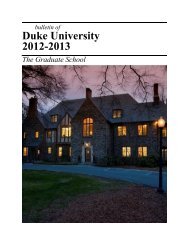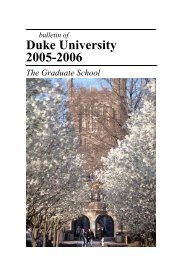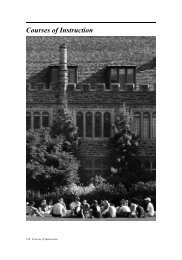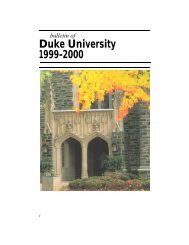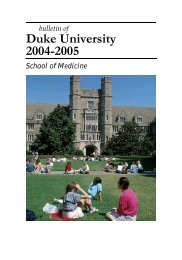Duke University 2009-2010 - Office of the Registrar - Duke University
Duke University 2009-2010 - Office of the Registrar - Duke University
Duke University 2009-2010 - Office of the Registrar - Duke University
You also want an ePaper? Increase the reach of your titles
YUMPU automatically turns print PDFs into web optimized ePapers that Google loves.
218. Integrated Circuit Engineering. Basic processing techniques and layout technology for integrated circuits.<br />
Photolithography, diffusion, oxidation, ion implantation, and metallization. Design, fabrication, and testing <strong>of</strong><br />
integrated circuits. Prerequisite: Electrical and Computer Engineering 162 or 163L. Instructor: Fair. 3 units.<br />
219. Digital Integrated Circuits. Analysis and design <strong>of</strong> digital integrated circuits. IC technology. Switching characteristics<br />
and power consumption in MOS devices, bipolar devices, and interconnects. Analysis <strong>of</strong> digital circuits<br />
implemented in NMOS, CMOS, TTL, ECL, and BiCMOS. Propagation delay modeling. Analysis <strong>of</strong> logic (inverters,<br />
gates) and memory (SRAM, DRAM) circuits. Influence <strong>of</strong> technology and device structure on performance and<br />
reliability <strong>of</strong> digital ICs. SPICE modeling. Prerequisites: Electrical and Computer Engineering 162 and 163L.<br />
Instructor: Massoud. 3 units.<br />
225. Nanophotonics. Theory and applications <strong>of</strong> nanophotonics and sub-wavelength optics. Photonic crystals, near-field<br />
optics, surface-plasmon optics, microcavities, and nanoscale light emitters. Prerequisite: Electrical and Computer<br />
Engineering 53L or equivalent. Instructor: Yoshie. 3 units.<br />
226. Optoelectronic Devices. Devices for conversion <strong>of</strong> electrons to photons and photons to electrons. Optical processes<br />
in semiconductors: absorption, spontaneous emission and stimulated emission. Light-emitting diodes (LEDs),<br />
semiconductor lasers, quantum-well emitters, photodetectors, modulators and optical fiber networks. Prerequisite:<br />
Electrical and Computer Engineering 216 or equivalent. Instructor: Stiff-Roberts. 3 units.<br />
227. Quantum Information Science. Fundamental concepts and progress in quantum information science. Quantum<br />
circuits, quantum universality <strong>the</strong>orem, quantum algorithms, quantum operations and quantum error correction codes,<br />
fault-tolerant architectures, security in quantum communications, quantum key distribution, physical systems for<br />
realizing quantum logic, quantum repeaters and long-distance quantum communication. Prerequisites: ECE 211 or<br />
Physics 211 or equivalent. Instructor: Kim. 3 units. C-L: Physics 272<br />
241. Linear System Theory and Optimal Control. Consideration <strong>of</strong> system <strong>the</strong>ory fundamentals; observability,<br />
controllability, and realizability; stability analysis; linear feedback, linear quadratic regulators, Riccati equation, and<br />
trajectory tracking. Prerequisite: Electrical and Computer Engineering 141. Instructor: P. Wang. 3 units.<br />
243. Pattern Classification and Recognition Technology. Theory and practice <strong>of</strong> recognition technology: pattern<br />
classification, pattern recognition, automatic computer decision-making algorithms. Applications covered include<br />
medical diseases, severe wea<strong>the</strong>r, industrial parts, biometrics, bioinformation, animal behavior patterns, image<br />
processing, and human visual systems. Perception as an integral component <strong>of</strong> intelligent systems. This course prepares<br />
students for advanced study <strong>of</strong> data fusion, data mining, knowledge base construction, problem-solving methodologies<br />
<strong>of</strong> "intelligent agents" and <strong>the</strong> design <strong>of</strong> intelligent control systems. Prerequisites: Ma<strong>the</strong>matics 107, Statistics 113 or<br />
Ma<strong>the</strong>matics 135, Computer Science 6, or consent <strong>of</strong> instructor. Instructor: Collins or P. Wang. 3 units.<br />
245. Digital Control Systems. Review <strong>of</strong> traditional techniques used for <strong>the</strong> design <strong>of</strong> discrete-time control systems;<br />
introduction <strong>of</strong> ''nonclassical'' control problems <strong>of</strong> intelligent machines such as robots. Limitations <strong>of</strong> <strong>the</strong> assumptions<br />
required by traditional design and analysis tools used in automatic control. Consent <strong>of</strong> instructor required. Instructor:<br />
Staff. 3 units.<br />
246. Optimal Control. Review <strong>of</strong> basic linear control <strong>the</strong>ory and linear/nonlinear programming. Dynamic programming<br />
and <strong>the</strong> Hamilton-Jacobi-Bellman Equation. Calculus <strong>of</strong> variations. Hamiltonian and costatic equations. Pontryagin's<br />
Minimum Principle. Solution to common constrained optimization problems. This course is designed to satisfy <strong>the</strong> need<br />
<strong>of</strong> several engineering disciplines. Prerequisite: Electrical and Computer Engineering 141 or equivalent. Instructor:<br />
Staff. 3 units. C-L: Mechanical Engineering and Materials Science 232<br />
251. Advanced Digital System Design. This course covers <strong>the</strong> fundamentals <strong>of</strong> advanced digital system design, and <strong>the</strong><br />
use <strong>of</strong> a hardware description language, VHDL, for <strong>the</strong>ir syn<strong>the</strong>sis and simulation. Examples <strong>of</strong> systems considered<br />
include <strong>the</strong> arithmetic/logic unit, memory, and microcontrollers. The course includes an appropriate capstone design<br />
project that incorporates engineering standards and realistic constraints in <strong>the</strong> outcome <strong>of</strong> <strong>the</strong> design process.<br />
Additionally, <strong>the</strong> designer must consider most <strong>of</strong> <strong>the</strong> following: Cost, environmental impact, manufacturability, health<br />
and safety, ethics, social and political impact. Each design project is executed by a team <strong>of</strong> 4 or 5 students who are<br />
responsible for generating a final written project report and making an appropriate presentation <strong>of</strong> <strong>the</strong>ir results to <strong>the</strong><br />
class. Prerequisite: Electrical and Computer Engineering 52L and Senior/graduate student standing. Instructor: Derby.<br />
3 units.<br />
252. Advanced Computer Architecture I. 3 units. C-L: see Computer Science 220<br />
253. Parallel System Performance. Intrinsic limitations to computer performance. Amdahl's Law and its extensions.<br />
Components <strong>of</strong> computer architecture and operating systems, and <strong>the</strong>ir impact on <strong>the</strong> performance available to<br />
applications. Intrinsic properties <strong>of</strong> application programs and <strong>the</strong>ir relation to performance. Task graph models <strong>of</strong><br />
parallel programs. Estimation <strong>of</strong> best possible execution times. Task assignment and related heuristics. Load balancing.<br />
Specific examples from computationally intensive, I/O intensive, and mixed parallel and distributed computations.<br />
Global distributed system performance. Prerequisites: Computer Science 110; Electrical and Computer Engineering<br />
152. Instructor: Staff. 3 units.<br />
Departments, Programs, and Course Offerings 113


